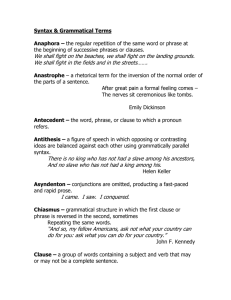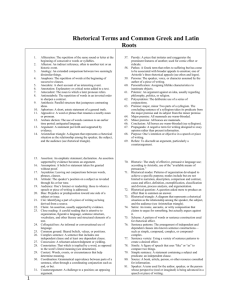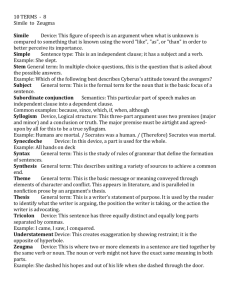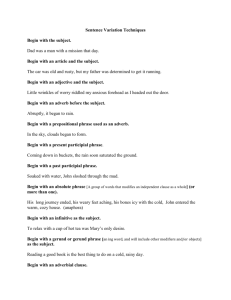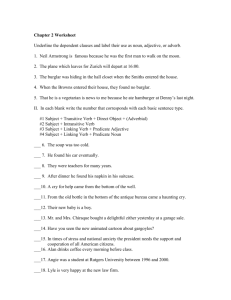Vocabulary List Allegory using a character and/or story elements
advertisement
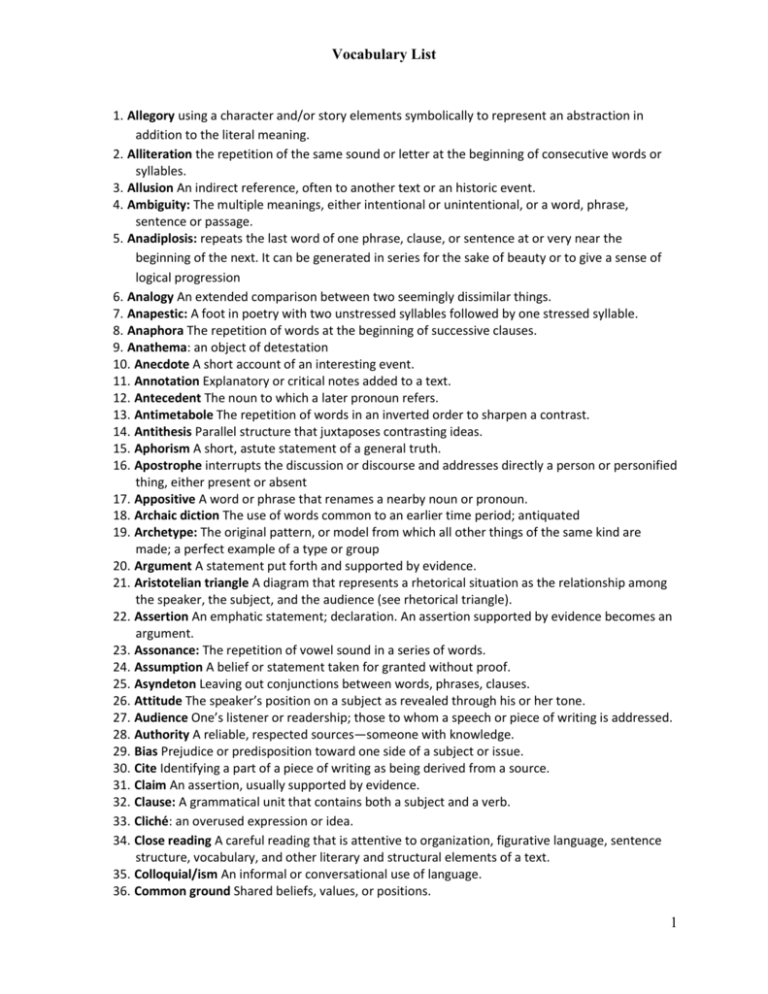
Vocabulary List 1. Allegory using a character and/or story elements symbolically to represent an abstraction in addition to the literal meaning. 2. Alliteration the repetition of the same sound or letter at the beginning of consecutive words or syllables. 3. Allusion An indirect reference, often to another text or an historic event. 4. Ambiguity: The multiple meanings, either intentional or unintentional, or a word, phrase, sentence or passage. 5. Anadiplosis: repeats the last word of one phrase, clause, or sentence at or very near the beginning of the next. It can be generated in series for the sake of beauty or to give a sense of logical progression 6. Analogy An extended comparison between two seemingly dissimilar things. 7. Anapestic: A foot in poetry with two unstressed syllables followed by one stressed syllable. 8. Anaphora The repetition of words at the beginning of successive clauses. 9. Anathema: an object of detestation 10. Anecdote A short account of an interesting event. 11. Annotation Explanatory or critical notes added to a text. 12. Antecedent The noun to which a later pronoun refers. 13. Antimetabole The repetition of words in an inverted order to sharpen a contrast. 14. Antithesis Parallel structure that juxtaposes contrasting ideas. 15. Aphorism A short, astute statement of a general truth. 16. Apostrophe interrupts the discussion or discourse and addresses directly a person or personified thing, either present or absent 17. Appositive A word or phrase that renames a nearby noun or pronoun. 18. Archaic diction The use of words common to an earlier time period; antiquated 19. Archetype: The original pattern, or model from which all other things of the same kind are made; a perfect example of a type or group 20. Argument A statement put forth and supported by evidence. 21. Aristotelian triangle A diagram that represents a rhetorical situation as the relationship among the speaker, the subject, and the audience (see rhetorical triangle). 22. Assertion An emphatic statement; declaration. An assertion supported by evidence becomes an argument. 23. Assonance: The repetition of vowel sound in a series of words. 24. Assumption A belief or statement taken for granted without proof. 25. Asyndeton Leaving out conjunctions between words, phrases, clauses. 26. Attitude The speaker’s position on a subject as revealed through his or her tone. 27. Audience One’s listener or readership; those to whom a speech or piece of writing is addressed. 28. Authority A reliable, respected sources—someone with knowledge. 29. Bias Prejudice or predisposition toward one side of a subject or issue. 30. Cite Identifying a part of a piece of writing as being derived from a source. 31. Claim An assertion, usually supported by evidence. 32. Clause: A grammatical unit that contains both a subject and a verb. 33. Cliché: an overused expression or idea. 34. Close reading A careful reading that is attentive to organization, figurative language, sentence structure, vocabulary, and other literary and structural elements of a text. 35. Colloquial/ism An informal or conversational use of language. 36. Common ground Shared beliefs, values, or positions. 1 Vocabulary List 37. Complex sentence A sentence that includes one independent clause and at least one dependent clause. 38. Concession A reluctant acknowledgment or yielding. 39. Connotation That which is implied by a word, as opposed to the word’s literal meaning. 40. Context Words, events, or circumstances that help determine meaning. 41. Coordination Grammatical equivalence between parts of a sentence, often through a coordinating conjunction such as and, or but. 42. Counterargument A challenge to a position; an opposing argument. 43. Credible Worthy of belief; trustworthy. 44. Cumulative sentence An independent clause followed by subordinate clauses or phrases that supply additional detail. 45. Declarative sentence A sentence that makes a statement. 46. Deduction Reasoning from general to specific. 47. Denotation The literal meaning of a word; its dictionary definition. 48. Dialectal journal A double-column journal in which one writes a quotation in one column and reflections on that quotation in the other column. 49. Diction Word choice. 50. Documentation Bibliographic information about the sources used in a piece of writing. 51. Elegiac Mournful over what has passed or been lost; often used to describe tone. 52. Epigram A brief witty statement. 53. Ethos A Greek term referring to the character of a person; one of Aristotle’s three rhetorical appeals. 54. Explication of text Explanation of a text’s meaning through an analysis of all of its constituent parts, including the literary devices used; also called close reading. 55. Facts Information that is true or demonstrable. 56. Figurative language The use of tropes or figures of speech; going beyond literal meaning to achieve literary effect. 57. Figure of speech an expression that strives for literary effect rather than conveying a literal meaning. 58. Fragment A word, phrase, or clause that does not form a full sentence. 59. Hortatory Urging, or strongly encouraging. 60. Hyperbole Exaggeration for the purpose of emphasis. 61. Imagery Vivid use of language that evokes a reader’s senses (sight, smell, taste, touch, hearing). 62. Imperative sentence A sentence that requests or commands. 63. Induction Reasoning from specific to general. 64. Inversion A sentence in which the verb precedes the subject. 65. Irony A contradiction between what is said and what is meant; incongruity between action and result. 66. Juxtaposition Placement of two things side by side for emphasis. 67. Logos A Greek term that means “word”; an appeal to logic; one of Aristotle’s three rhetorical appeals. 68. Metaphor A figure of speech or trope through which one thing is spoken of as though it were something else, thus making an implicit comparison. 69. Metonymy Use of an aspect of something to represent the whole. 70. Modifier A word, phrase, or clause that qualifies or describes another word, phrase, or clause. 71. Narration Retelling an event or series of events. 72. Nominalization Turning a verb or adjective into a noun. 73. Occasion An aspect of context; the cause or reason for writing. 2 Vocabulary List 74. Omniscient narrator An all-knowing, usually third-person narrator. 75. Oxymoron A figure of speech that combines two contradictory terms. 76. Pacing The relative speed or slowness with which a story is told or an idea is presented. 77. Paradox A statement that seems contradictory but is actually true. 78. Parallelism The repetition of similar grammatical or syntactical patterns. 79. Parody A piece that imitates and exaggerates the prominent features of another; used for comic effect or ridicule. 80. Pathos A Greek term that refers to suffering but has come to be associated with broader appeals to emotion; one of Aristotle’s three rhetorical appeals. 81. Periodic sentence A sentence that builds toward and ends with the main clause. 82. Persona The speaker, voice, or character assumed by the author of a piece of writing. 83. Personification Assigning lifelike characteristics to inanimate objects. 84. Polemic An argument against an idea, usually regarding philosophy, politics, or religion. 85. Polysyndeton The deliberate use of a series of conjunctions. 86. Premise; major, minor Two parts of a syllogism. The concluding sentence of a syllogism takes its predicate from the major premise and its subject from the minor premise. Major premise: All mammals are warm-blooded. Minor premise: All horses are mammals. Conclusion: All horses are warm-blooded (see syllogism). 87. Pronoun A word used to replace a noun or noun phrase. 88. Propaganda A negative term for writing designed to sway opinion rather than present information. 89. Purpose One’s intention or objective in a speech or piece of writing. 90. Refute To discredit an argument, particularly a counterargument. 91. Rhetoric The study of effective, persuasive language use; according to Aristotle, use of the “available means of persuasion.” 92. Rhetorical modes Patterns of organization developed to achieve a specific purpose; modes include but are not limited to narration, description, comparison and contrast, cause and effect, definition, exemplification, classification and division, process analysis, and argumentation. 93. Rhetorical question a question asked more to produce an effect than to summon an answer. 94. Rhetorical triangle A diagram that represents a rhetorical situation as the relationship among the speaker, the subject, and the audience. 95. Satire An ironic, sarcastic, or witty composition that claims to argue for something, but actually argues against it. 96. Scheme A pattern of words or sentence construction used for rhetorical effect. 97. Sentence patterns The arrangement of independent and dependent clauses into known sentence constructions—such as simple, compound, complex, or compound-complex. 98. Sentence variety Using a variety of sentence patterns to create a desired effect. 99. Simile A figure of speech that uses “like” or “as” to compare two things. 100. Simple sentence a statement containing a subject and predicate; an independent clause. 101. Source A book, article, person, or other resource consulted for information. 102. Speaker A term used for the author, speaker, or the person whose perspective (real or imagined) is being advanced in a speech or piece of writing. 103. Straw man a logical fallacy that involves the creation of an easily refutable position; misrepresenting, then attacking an opponent’s position. 104. Style The distinctive quality of speech or writing created by the selection and arrangement of words and figures of speech. 105. Subject In rhetoric, the topic addressed in a piece of writing. 3 Vocabulary List 106. Subordinate clause Created by a subordinating conjunction, a clause that modifies an independent clause. 107. Subordination The dependence of one syntactical element on another in a sentence. 108. Syllogism A form of deductive reasoning in which the conclusion is supported by a major and minor premise (see premise; major, and minor). 109. Syntax Sentence structure. 110. Synthesize Combining or bringing together two or more elements to produce something more complex. 111. Thesis statement A statement of the central idea in a work may be explicit or implicit. 112. Thesis The central idea in a work to which all parts of the work refer. 113. Tone The speaker’s attitude toward the subject or audience. 114. Topic sentence a sentence, most often appearing at the beginning of a paragraph that announces the paragraph’s idea and often unites it with the work’s thesis. 115. Trope Artful diction; the use of language in a non-literal way; also called a figure of speech. 116. Understatement Lack of emphasis in a statement or point; restraint in language often used for ironic effect. 117. Voice In grammar, a term for the relationship between a verb and a noun (active or passive voice). In rhetoric, a distinctive quality in the style and tone of writing. 118. Zeugma A construction in which one word (usually a verb) modifies or governs—often in different, sometimes incongruent ways—two or more words in a sentence. 4

